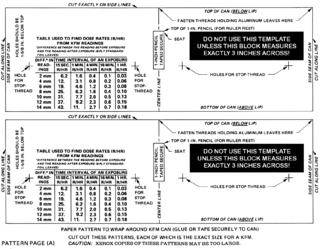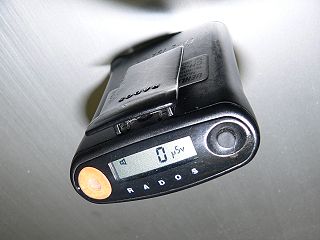
A radiation dosimeter is a device that measures dose uptake of external ionizing radiation. It is worn by the person being monitored when used as a personal dosimeter, and is a record of the radiation dose received. Modern electronic personal dosimeters can give a continuous readout of cumulative dose and current dose rate, and can warn the wearer with an audible alarm when a specified dose rate or a cumulative dose is exceeded. Other dosimeters, such as thermoluminescent or film types, require processing after use to reveal the cumulative dose received, and cannot give a current indication of dose while being worn.

An electrometer is an electrical instrument for measuring electric charge or electrical potential difference. There are many different types, ranging from historical handmade mechanical instruments to high-precision electronic devices. Modern electrometers based on vacuum tube or solid-state technology can be used to make voltage and charge measurements with very low leakage currents, down to 1 femtoampere. A simpler but related instrument, the electroscope, works on similar principles but only indicates the relative magnitudes of voltages or charges.

The Geiger–Müller tube or G–M tube is the sensing element of the Geiger counter instrument used for the detection of ionizing radiation. It is named after Hans Geiger, who invented the principle in 1908, and Walther Müller, who collaborated with Geiger in developing the technique further in 1928 to produce a practical tube that could detect a number of different radiation types.
Radiation dosimetry in the fields of health physics and radiation protection is the measurement, calculation and assessment of the ionizing radiation dose absorbed by an object, usually the human body. This applies both internally, due to ingested or inhaled radioactive substances, or externally due to irradiation by sources of radiation.
Radiation protection, also known as radiological protection, is defined by the International Atomic Energy Agency (IAEA) as "The protection of people from harmful effects of exposure to ionizing radiation, and the means for achieving this". Exposure can be from a source of radiation external to the human body or due to internal irradiation caused by the ingestion of radioactive contamination.
In physics, optically stimulated luminescence (OSL) is a method for measuring doses from ionizing radiation. It is used in at least two applications:

Health physics, also referred to as the science of radiation protection, is the profession devoted to protecting people and their environment from potential radiation hazards, while making it possible to enjoy the beneficial uses of radiation. Health physicists normally require a four-year bachelor’s degree and qualifying experience that demonstrates a professional knowledge of the theory and application of radiation protection principles and closely related sciences. Health physicists principally work at facilities where radionuclides or other sources of ionizing radiation are used or produced; these include research, industry, education, medical facilities, nuclear power, military, environmental protection, enforcement of government regulations, and decontamination and decommissioning—the combination of education and experience for health physicists depends on the specific field in which the health physicist is engaged.

The electroscope is an early scientific instrument used to detect the presence of electric charge on a body. It detects charge by the movement of a test object due to the Coulomb electrostatic force on it. The amount of charge on an object is proportional to its voltage. The accumulation of enough charge to detect with an electroscope requires hundreds or thousands of volts, so electroscopes are used with high voltage sources such as static electricity and electrostatic machines. An electroscope can only give a rough indication of the quantity of charge; an instrument that measures electric charge quantitatively is called an electrometer.

The proportional counter is a type of gaseous ionization detector device used to measure particles of ionizing radiation. The key feature is its ability to measure the energy of incident radiation, by producing a detector output pulse that is proportional to the radiation energy absorbed by the detector due to an ionizing event; hence the detector's name. It is widely used where energy levels of incident radiation must be known, such as in the discrimination between alpha and beta particles, or accurate measurement of X-ray radiation dose.
The ionization chamber is the simplest type of gaseous ionisation detector, and is widely used for the detection and measurement of many types of ionizing radiation, including X-rays, gamma rays, alpha particles and beta particles. Conventionally, the term "ionization chamber" refers exclusively to those detectors which collect all the charges created by direct ionization within the gas through the application of an electric field. It uses the discrete charges created by each interaction between the incident radiation and the gas to produce an output in the form of a small direct current. This means individual ionising events cannot be measured, so the energy of different types of radiation cannot be differentiated, but it gives a very good measurement of overall ionising effect.

A film badge dosimeter or film badge is a personal dosimeter used for monitoring cumulative radiation dose due to ionizing radiation.
Geiger counter is a colloquial name for any hand-held radiation measuring device in civil defense, but most civil defense devices were ion-chamber radiological survey meters capable of measuring only high levels of radiation that would be present after a major nuclear event.

Gaseous ionization detectors are radiation detection instruments used in particle physics to detect the presence of ionizing particles, and in radiation protection applications to measure ionizing radiation.

The hot-filament ionization gauge, sometimes called a hot-filament gauge or hot-cathode gauge, is the most widely used low-pressure (vacuum) measuring device for the region from 10−3 to 10−10 Torr. It is a triode, with the filament being the cathode.

An electrostatic fieldmeter, also called a static meter is a tool used in the static control industry. It is used for non-contact measurement of electrostatic charge on an object. It measures the force between the induced charges in a sensor and the charge present on the surface of an object. This force is converted to volts, measuring both the initial peak voltage and the rate at which it falls away.

The Kearny fallout meter, or KFM, is an expedient radiation meter. It is designed such that someone with a normal mechanical ability would be able to construct it before or during a nuclear attack, using common household items.

The electronic personal dosimeter (EPD) is a modern electronic dosimeter for estimating uptake of ionising radiation dose of the individual wearing it for radiation protection purposes. The electronic personal dosimeter has the advantages over older types that it has a number of sophisticated functions, such as continuous monitoring which allows alarm warnings at preset levels and live readout of dose accumulated. It can be reset to zero after use, and most models allow near field electronic communications for automatic reading and resetting.
Francis Rudolph Shonka was a physicist and inventor. Shonka was known for his pioneering work with ionizing radiation measurement devices and equipment. This equipment bears his name today as the: Shonka ionization chamber, the Shonka electrometer, and Shonka plastics.













